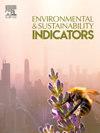藏羌彝走廊多层次城市发展边界的政策导向框架
IF 5.4
Q1 ENVIRONMENTAL SCIENCES
引用次数: 0
摘要
城市发展边界是调节城市土地扩张和构建领土空间格局的重要工具。然而,主要功能区划对其划定的影响仍未得到充分探讨。本研究结合二元评价体系和乡镇级功能区划的结果,确定适宜和不适宜城市建设的区域。利用PLUS模型,模拟了2035年盼西干谷土地利用变化,并结合凸壳模型验证,构建了包括基线边界、弹性边界和优先边界在内的多层次城市发展边界系统。结果表明:(1)西部次区域以生态保护为主,中部次区域以农业生产和城市发展并重;②自然发展情景下,到2035年建设用地规模大幅扩大,而政策驱动情景有效限制了建设用地规模的扩大,政策约束的调控作用突出;(3)基线边界、弹性边界和优先边界分别为313.37 km2、5882.12 km2和25,023.94 km2。该方法将空间规划与政策导向约束相结合,为分层边界划分提供了系统框架。它有助于协调城市发展、耕地保护和生态保护的相互矛盾的需求,为促进区域协调发展提供实践见解。本文章由计算机程序翻译,如有差异,请以英文原文为准。
Policy-oriented framework for multi-tiered urban development boundaries in the Tibetan-Qiang-Yi corridor
Urban development boundaries are essential instruments for regulating urban land expansion and structuring territorial spatial patterns. However, the influence of primary functional zoning on their delineation remains underexplored. This study integrates results from the dual evaluation system and township-level functional zoning to identify areas suitable and unsuitable for urban construction. Using the PLUS model, it simulates land use changes in the Panxi Dry Valley by 2035 and incorporates convex hull model validation to construct a multi-tiered urban development boundary system—comprising baseline, elastic, and priority boundaries. The results indicate that: (1) the western subregion emphasizes ecological protection, whereas the central subregion prioritizes both agricultural production and urban development; (2) under the Natural Development Scenario, construction land expands substantially by 2035, while the Policy-Driven Scenario effectively limits expansion, highlighting the regulatory role of policy constraints; and (3) the areas delineated for the baseline, elastic, and priority boundaries are 313.37 km2, 5882.12 km2, and 25,023.94 km2, respectively. This approach integrates spatial planning with policy-oriented constraints, providing a systematic framework for hierarchical boundary delineation. It helps reconcile competing demands for urban development, cropland protection, and ecological conservation, offering practical insights for promoting coordinated regional development.
求助全文
通过发布文献求助,成功后即可免费获取论文全文。
去求助
来源期刊

Environmental and Sustainability Indicators
Environmental Science-Environmental Science (miscellaneous)
CiteScore
7.80
自引率
2.30%
发文量
49
审稿时长
57 days
 求助内容:
求助内容: 应助结果提醒方式:
应助结果提醒方式:


